Applying the Butler Model to Tourism in Sitges and Calafell
Sitges and Calafell are approximately equal-sized settlements lying to the south west of Barcelona (see Figure 1). Both rely on tourism as a major source of income and employment and the study aims to compare the relative success of tourism, in its various forms, by employing the Butler Model.
 |
| Figure 1. The location of Sitges and Calafell |
The Butler Model is a method used to study the evolution of tourism over time and at which stage of the development model a settlement happens to be at this point in time. Tourism is a major source of income for many settlements and those on the Spanish coastline are no exception. Tourism has grown in importance as a major generator of wealth because of three main factors:
-
The increased leisure time that people now have as a result of longer paid holidays, lengthier retirements and shorter working hours and weeks.
-
An increase in disposable income. This refers to the money available to the individual or family once all fixed costs, such as mortgage or rent, utilities, food etc have been paid for.
-
The greater ease of travel with developments in air and land transportation.
Both Sitges and Calafell have developed for these reasons.
Sitges - a brief history
Sitges is a town of approximately 25,000 people and is located about 30 km south of Barcelona. Originally occupied by the Romans on a defensive headland looking out to sea, Sitges’ port was used to trade products from the Penedès region and other places from the Roman Mediterranean.
Despite its direct contact with the sea, the town had more peasant farmers than fishermen, with vineyards being the main economic activity.
In the 18th century Catalonia obtained permission to trade directly with the West Indian Spanish colonies and by 1833 more than 27% of the Catalans trading with Cuba were Sitgetans. The fortunes made were invested in the purchase or repair of the town's old houses.
Sitges, although located close to Barcelona, was still hard to access at the time, but began to develop as a summer resort for taking the waters. As early as 1879, there are records showing that baths were already being used as medicinal therapy and spa enthusiasts directly became beach enthusiasts. However, it was not until 1881, with the arrival of the railway line from Barcelona, that tourism in Sitges really began to develop.
With the arrival of Santiago Rusiñol in 1891 - one of the architects of Modernism - Sitges became the cultural centre of the modernists. In 1909, Sitges was visited by Charles Deering, a North American millionaire who converted a street in the historic core into a palace, the Palau Maricel. This palace and Rusiñol’s residence helped launch Sitges to tourist fame. In 1918, the Terramar garden city and the Passeig Maritim or Esplanade were constructed. Atracción de Forasteros (Tourist Attraction Company) was created in 1928 and the Tourist Information Office in 1934. From then on, Sitges would become a European tourism standard setter.
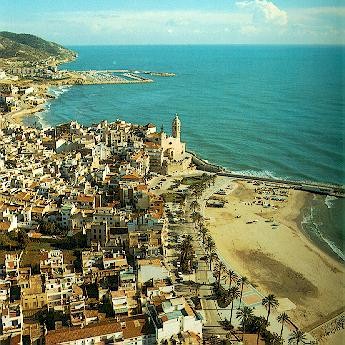 |
| Aerial view of Sitges' historic core |
Calafell - a brief history
Calafell has a population of approximately 25,000 people and lies 50 km south of Barcelona. It owes its origins to a castle and occupied a defensive site on an inland hill. The name Calafell means 'small castle' and the earliest reference to it dates from 999AD. For years the economy of Calafell was devoted to agriculture and fishing.
Like Sitges, the arrival in the late 1880's of the railway from Barcelona led to a change in its economic fortunes. Calafell became more accessible and the development of second homes around the railway stations flourished with the 1947 Garden City project known as the Quadra de Segur. At first people lived there only during holiday periods, but now the majority of the population are permanent residents.
It was not until the 1960's that tourism began to develop strongly in Calafell, especially along the 5km of uninterrupted beach where numerous apartment buildings and hotels were constructed. With the blessing of successive city councils, a huge speculative boom in the 1970's led to an endless row of 6-storey apartments facing the sea. Later regulations prevented excessive vertical growth whilst inland the prohibition of building over two and a half floors led to more green space and a lower population density.
Today, the town of Calafell is delimited into three very distinct areas. To the north, narrow streets surround the castle and the old church. To the south, and disconnected from the historic core, the former seafront fishing village has been converted into tourist area. And to the east is Segur de Calafell, a former Garden City of second homes developed on farmland surrounding the railway station.
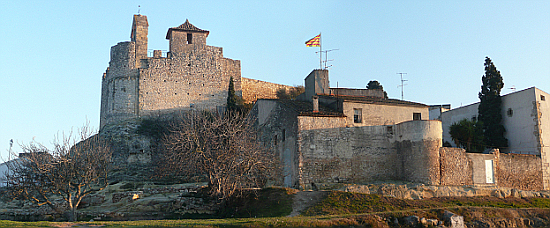 |
| Calafell castle: the historic core of Calafell is disconnected from the seafront beach resort |
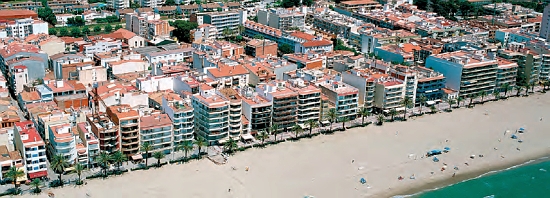 |
| Calafell seafront: 6-storey apartments facing the sea |
The Butler Model: what is it looking at?
In Geographical terms, a model is a simplification of reality. The purpose of the Butler Model is to look at the way that tourist resorts, grow and develop. The tourist industry, like all industry, is dynamic and constantly changing. Therefore, the Butler Model is a way of studying tourist resorts and seeing how they change over time and in relation to the changing demands of the tourist industry. These changes can then be compared to the predictions as shown on the model.
The Butler Model (see Figure 2) breaks down tourist development into five distinct stages.
1. Discovery Stage
A settlement is 'explored' or 'discovered' by a small number of people who later
tell others about their experience. In time other people visit and local people
seize upon the new economic opportunities provided by these visitors and provide
services to meet the needs of these visitors or tourists.
2. Growth and Development Stage
More tourists arrive having heard about the place by word of mouth, articles in
Travel Supplements in papers such as The Sunday Times, brochures or tourist
guides. The extra tourists attracted by the publicity and people willing to
visit somewhere new will lead to the building of new hotels, restaurants, shops
and services to cater for the influx of people.
3. Success Stage
As more people visit the resort, the facilities are now fully utilised. At this
stage mass tourism replaces what was once the original economic function of the
settlement. This may cause some resentment with people in the town who have not
benefited from the new industry or from the loss of distinct identity that the
settlement held before. It may appear that the local culture is being diminished
by a more international and non-unique culture compared to what may have existed
before.
4. Problem – Stagnation Stage
Popularity may be short lived. People may become bored with the resort once its
initial appeal had waned. Little of the original natural environment will remain
and negative comments about what it used to be like may lead people to find
somewhere new to discover. The effect of falling tourism if a resort goes out of
fashion leads to economic decline and the under-utilisation of tourist
infrastructure. The eventual closure of some of the businesses will lead to a
rise in unemployment.
5. Decline or Rejuvenation
The tourist resort then has two options; either go into decline or rejuvenate
and develop more sustainable strategies based upon lower visitor numbers.
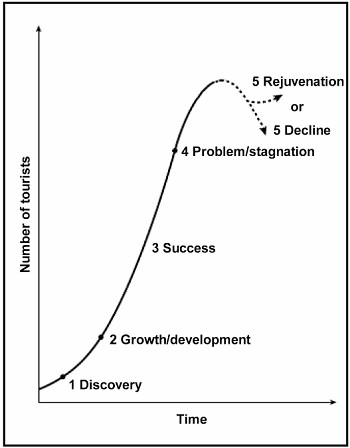 |
| Figure 2. The five stages of the Butler Model as applied to Sitges and Calafell |
The Butler Model applied to Sitges
1. Sitges Discovery
Sitges was discovered early by people from the city of Barcelona. It later began
to attract many artists and intellectuals such as Rusiñol. Many wealthy
Catalans also built second homes in Sitges to escape a much polluted Barcelona.
Much of the early wealth of Sitges was based on trade with the West Indies and
Cuba in particular. The houses on the southern part of the Esplanade reflect
this Cuban influence.
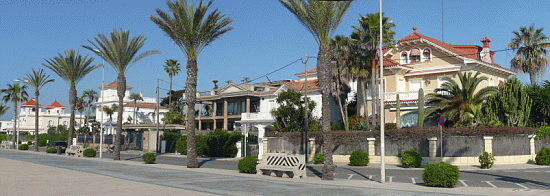 |
| Cuban-style mansions along the Sitges seafront |
2. Sitges Growth and Development
The local tourist industry remained in place until the developments of the
1960's when tourism from overseas first began to filter into the town. The
development of the package holiday whereby passengers booked flights, transfers
and accommodation all in one booking made places such as Sitges accessible to
people from Northern Europe. Furthermore, the use of jet aircraft made such
perceived epic journeys now possible in under half of a day. Sitges responded to
these developments with the construction of large hotels such as the Terramar
and Calipolis on the sea front. Other smaller hotels were also built, often in
converted Cubanesque houses. Restaurants, shops and bars also opened to cater
for the needs of the increased number of tourists who visited in the main season
extending from mid-May until the end of September.
3. Sitges Success
Sitges is now a major tourist resort, perceived as high status and catering for
more affluent visitors. It has a wide range of 36 hotels and 12 pensions,
totaling 2,540 rooms. It is popular with the gay community, many of whom holiday
in Sitges during the summer season. This has added to the success of the town
and is further reflected in the range of high status shops and restaurants found
there. There are over 150 clothes shops and 175 bars and restaurants, four times
more than expected in a town the size of Sitges.
Sitges has also attracted many migrants not just to work in the tourist industry
but also others to live in the town. These include wealthy people from elsewhere
in Spain, as well as others from around the world. The migrants comprise of 63%
from Europe and 30% from Latin America. Many of the Europeans are living
permanently in Sitges while others own second homes in the town.
Proximity to Barcelona airport and the advent of low-cost airlines such as
Easyjet and Ryanair have been an added boost to Sitges in attracting people on
short breaks. Today large numbers of the tourists are independent travellers,
making all of their own holiday arrangements via the internet rather than using
a High Street travel agency. This has been especially important since the
economic downturn as the majority of visitors are here for short breaks only.
4 Sitges Stagnation
Tourism trends change. Many of the early tourists to Sitges now looked for
cheaper alternatives to places they may have visited before or become tired of.
New resorts opened as the Mediterranean countries of Greece, Turkey, Cyprus and
others developed their tourist potential and more established resorts such as
Sitges saw a fall in their traditional client base.
This phase saw holiday companies such as Thompson remove Sitges from their
holiday brochures.
5 Sitges Decline or Rejuvenation
The fall in the traditional tourist base has led Sitges to try to develop more
sustainable strategies. Many environmental improvements are in progress and the
resort has been rebranded as an all-year destination. To this end the calendar
of events that Sitges offers extends well beyond the traditional holiday season.
The calendar below illustrates some of the activities on offer in 2011.
| January 9 | Sitges Half Distance Marathon |
| March 3 -9 | Carnival with parades on Sunday 6 and Tuesday 8. |
| March 17 - 20 | International Patchwork Festival |
| March 26 - 27 | 18th Sitges Art Exhibition |
| March 27 | Barcelona-Sitges International Vintage Car Rally |
| April 21 - 24 | International Classic Ballet Competition |
| April 28 - May 1 | College Football Tournament and Beach Volleyball |
| May 27 - 29 | Sitges Swing Festival |
| June 25 - 26 | Rugby Sevens |
| June 26 | Corpus Christi Festival, 59th Flower Carpet Competition |
| July and August | International Music Festival |
| August 21 -27 | Fiesta Major with fireworks on the 23rd |
| September 16 - 18 | 50th Grape Harvest Festival |
| September 17 – 18 | Wine Tasting Experience |
| September 22 - 23 | Santa Tecla, Saints Day with fireworks on the 22nd |
| October 6 - 16 | International Film Festival of Catalonia |
| November 13 | Ecological Cycling Barcelona - Sitges |
Sitges Activities Calendar 2011
The extension of the season has been promoted with the production of a DVD with the theme 'Sitges the art of living'. This appeals to high income professional groups to make Sitges a permanent base for multiple short breaks in the Mediterranean sun.
Sitges has capitalised on its proximity to Barcelona to become one of the main destinations for Business and Conference tourism in Catalonia. Its specialised hotels in this sector include the Dolce Sitges, with over 30 meeting rooms and the Meliá Sitges, with a conference hall seating more than 1,300 delegates and 16 meeting rooms.
Furthermore, the Sitges Council is embarking on a project called 'QUALIA Sitges' to enhance tourism by exploiting what is called the 'creative economy'. This refers to the development of activities relating to creativity, art and culture which will compliment Sitges' tourist based economy. It aims to build upon the earlier role of Sitges as a centre of art and culture based upon the works of the artist Rusiñol in the late nineteenth and early twentieth centuries. It aims to encourage and promote cultural and artistic tradition with new technology.
The project is a long term plan covering the next ten years and will see the development of a state of the art campus with a school of music and dance, a University of the Performing Arts and a Design Centre. These facilities will bring in to Sitges up to 2,000 students a year as well as a further 2000 jobs including academic staff and other professionals working in the QUALIA facility. It has been estimated that each student will spend approximately 750€ per month in Sitges of which 150€ will be on tourist and leisure facilities. Added to this are the family and friends of the students coming to see them who are expected to add a further 25,000 guest nights in Sitges and the use of the town's tourist facilities.
Therefore, Sitges can be seen as moving forward in its plans to remain a major leisure destination by diversifying to ensure long term sustainability.
The Butler Model applied to Calafell
1. Discovery
Calafell, like Sitges, benefited from the opening of the railway line but
because of its greater distance from Barcelona, there was very slow development
until a huge speculative boom in the 1970's. Developers constructed hotels and
apartments to take advantage of the resort's greatest asset - its long and wide
beach.
2. Growth and Development
The construction of the promenade and the completion of the sea front apartments
and hotels attracted families from Madrid and northern Spain, particularly in
the summer months. New businesses opened to cater for the needs of these people.
3. Success
The 5 km stretch of coastline comprising the beach resort of Calafell became
fully occupied during the high seasons of the 1970's and 1980's. However,
Calafell never attracted the package tour operators in the way that Sitges has
done and the range of hotels is very limited.
4. Problem – Stagnation
The speculative boom of the 1970's and 1980's resulted in the destruction of
nearly all of Calafell's original seafront. The fishing cottages were replaced
by an endless row of 6-storey apartments facing the sea. As a result, the
seafront lacks character and charm and with the economic crisis and competition
from other resorts in Spain and overseas, the number of hotel rooms has
decreased by 17% in the last decade (from 1,690 in 1996 to 1402 in 2006).
The immigrant population now represents 20% of the total population of Calafell, having grown rapidly in recent years. However, Calafell has not attracted large numbers of wealthy people from elsewhere in Spain and Europe in the way Sitges has. Instead, approximately 50% of the immigrants are from North Africa, settling in the area of Segur de Calafell.
Calafell thus seems to be in stagnation or decline mode.
 |
| Calafell: only one cottage from the original seafront remains today |
5. Decline or Rejuvenation
Like Sitges, the fall in the traditional tourist base has led Calafell to try to
develop more sustainable strategies. Many environmental improvements are in
progress and the resort has been rebranded as an all-year destination. However,
tourism in Calafell has taken a rather different path to Sitges.
The family-orientated nature of the resort has been promoted, with Calafell earning the 'Family Holiday Destination certificate' from the Catalan government in 2007. This recognised the family-oriented accommodation, restaurants and a range of leisure activities provided. Calafell has a Children's Club in the summer months and, like Sitges, has a tourist train running along the sea front and a second linking the beach area with the historic core inland.
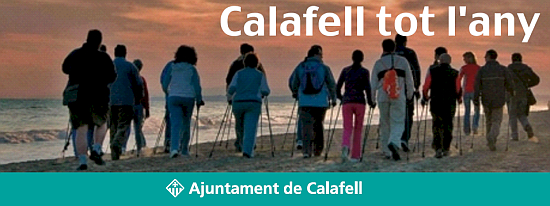 |
| 'Calafell, all year' - Calafell is a pioneer resort in Nordic walking |
Calafell has helped pioneer the trend for more active holiday pursuits and in 2008 became the first resort in Spain to offer Nordic walking. This, together with trekking and mountain biking are provided free of charge, with certified guides. However, despite adopting the slogan 'Calafell tot l'any' ('Calafell, all year'), the resort has struggled to extend the tourist season as effectively as Sitges.
Calafell's 2009 Municipal Urban Plan (POUM) seeks to stop the
uncontrolled urban growth of the town, protect the natural and historical
heritage and maintain and enhance the tourism that forms its economic base.
Calafell needs to widen its tourism offer and new economic activities need to be
attracted to diversify its economy if it is to avoid becoming a dormitory town
for Barcelona.
It can therefore be seen that both Sitges and Calafell cater for tourists but
are two very different towns. The proximity of Barcelona has enabled Sitges to
grow much more rapidly and diversify its tourism more effectively than Calafell
with the result that the two towns have developed and evolved in different ways.
The Field Study
The study involves visiting both towns and collecting data at five comparable locations in each town. These are the old historic core, the sea front, an area of historic buildings, a major shopping street and an entertainment street. Data will be collected at each site and later used to compare the two towns in relation to the Butler Model.
Students will be expected to prepare a presentation of their
findings and recommendations as to what could or should be done to improve the
tourist facility or experience, if deemed necessary.
Retail and Services Interactive Maps for Sitges and Calafell
